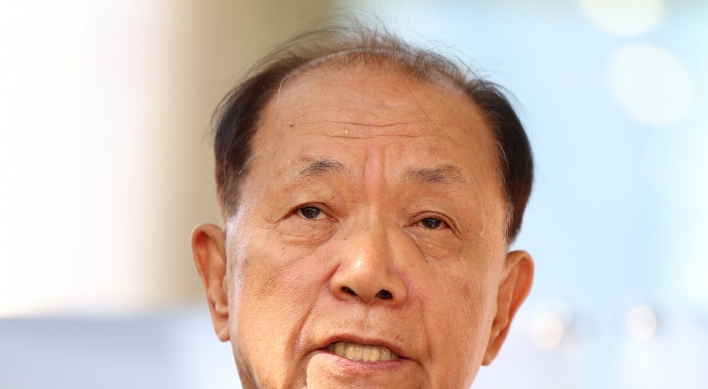Chinese art star Yue brings ‘laughing men’ to Europe
By Korea HeraldPublished : Nov. 14, 2012 - 20:09

PARIS (AFP) ― The painted grins are stretched so wide they seem to hurt. And that is pretty much what Yue Minjun intended, the Chinese artist explained at the Paris opening of his first major show in Europe.
A former electrician turned contemporary artist, Yue shot to international attention in 1999 when his signature laughing-man self-portraits made a much-noted eruption at the Art Biennale in Venice.
“If I paint laughter it is because I feel pain towards human life,” the 50-year-old, one of China’s most bankable art figures, told AFP through an interpreter. “I found a comical way to express something tragic.”
Where does this sense of tragedy come from? “It’s first and foremost a perception of human life. But it’s also a feeling towards the world we live in,” he offered.
Clothed in black, his head smooth, Yue confessed to feeling “a little anxious and shy” at the sight of the four dozen paintings and 100-odd sketches that went on show Wednesday at the Fondation Cartier, where they will remain to March 17.
“It’s the first time I’ve seen so many of my works displayed at the same time,” he told AFP. “It’s also the first time I get to examine myself.”
“I spotted quite a few clumsy touches in my paintings,” he quipped. “I said to myself I must be one of those painters who does not know how to hide. I say things in a direct and simple way.”
Yue’s cartoon-like characters are cast in contorted poses, or scenes that reference the cultural revolution, like the 2000 “Memory 4,” where a crowd of people inside a man’s skull tout what looks like Mao Zedong’s Little Red Book.
“Sunrise,” painted in 1998, features a crowd of laughing faces lifted towards the rising sun.
“A lot of visual memories stem from my childhood,” he explained. “It was the socialist experience. When I was a child, a great many works used to depict happy people, full of confidence, living an ideal life.”
Other works reference the European art canon, such as the 1995 “The Execution,” inspired by Goya and Manet, in which both the half-naked victims and gunmen are bent with laughter in front of what look like the walls of Beijing’s Forbidden City.
Seen as one of his most political works, “The Execution” fetched 3.74 million euros ($4.76 million) at auction at Sotheby’s in London in 2007.
But the artist does not like to be described as “political.” His critique is about culture, he says, namely the way that “in traditional Chinese civilization the individual is not important.”
A former electrician turned contemporary artist, Yue shot to international attention in 1999 when his signature laughing-man self-portraits made a much-noted eruption at the Art Biennale in Venice.
“If I paint laughter it is because I feel pain towards human life,” the 50-year-old, one of China’s most bankable art figures, told AFP through an interpreter. “I found a comical way to express something tragic.”
Where does this sense of tragedy come from? “It’s first and foremost a perception of human life. But it’s also a feeling towards the world we live in,” he offered.
Clothed in black, his head smooth, Yue confessed to feeling “a little anxious and shy” at the sight of the four dozen paintings and 100-odd sketches that went on show Wednesday at the Fondation Cartier, where they will remain to March 17.
“It’s the first time I’ve seen so many of my works displayed at the same time,” he told AFP. “It’s also the first time I get to examine myself.”
“I spotted quite a few clumsy touches in my paintings,” he quipped. “I said to myself I must be one of those painters who does not know how to hide. I say things in a direct and simple way.”
Yue’s cartoon-like characters are cast in contorted poses, or scenes that reference the cultural revolution, like the 2000 “Memory 4,” where a crowd of people inside a man’s skull tout what looks like Mao Zedong’s Little Red Book.
“Sunrise,” painted in 1998, features a crowd of laughing faces lifted towards the rising sun.
“A lot of visual memories stem from my childhood,” he explained. “It was the socialist experience. When I was a child, a great many works used to depict happy people, full of confidence, living an ideal life.”
Other works reference the European art canon, such as the 1995 “The Execution,” inspired by Goya and Manet, in which both the half-naked victims and gunmen are bent with laughter in front of what look like the walls of Beijing’s Forbidden City.
Seen as one of his most political works, “The Execution” fetched 3.74 million euros ($4.76 million) at auction at Sotheby’s in London in 2007.
But the artist does not like to be described as “political.” His critique is about culture, he says, namely the way that “in traditional Chinese civilization the individual is not important.”
-
Articles by Korea Herald







![[KH Explains] No more 'Michael' at Kakao Games](http://res.heraldm.com/phpwas/restmb_idxmake.php?idx=644&simg=/content/image/2024/04/28/20240428050183_0.jpg&u=20240428180321)











![[Herald Interview] Mistakes turn into blessings in street performance, director says](http://res.heraldm.com/phpwas/restmb_idxmake.php?idx=652&simg=/content/image/2024/04/28/20240428050150_0.jpg&u=20240428174656)
